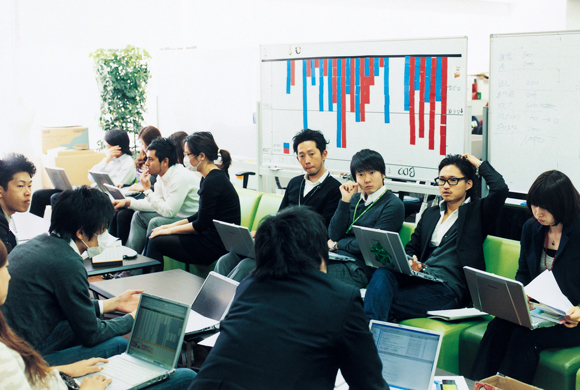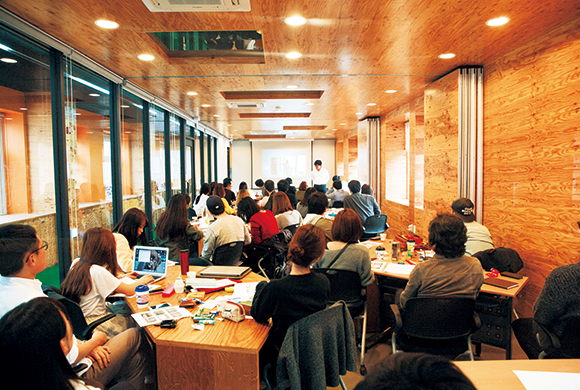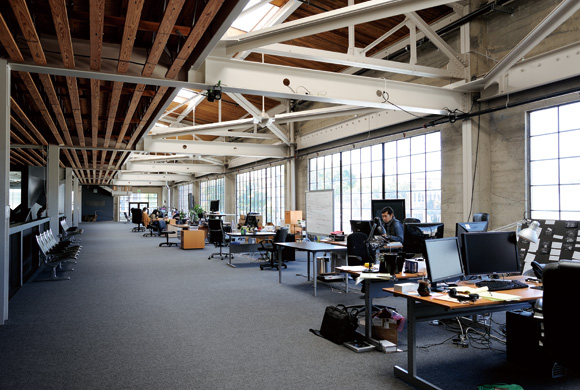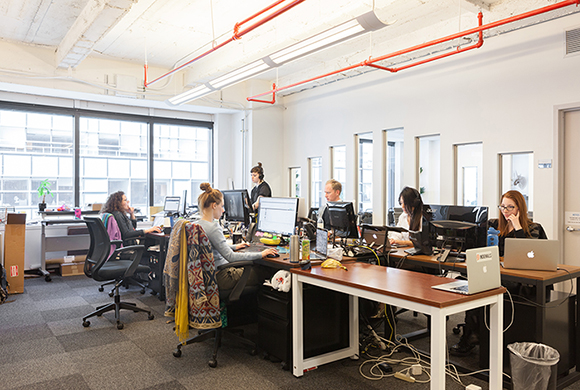Workplace
Nov. 11, 2013
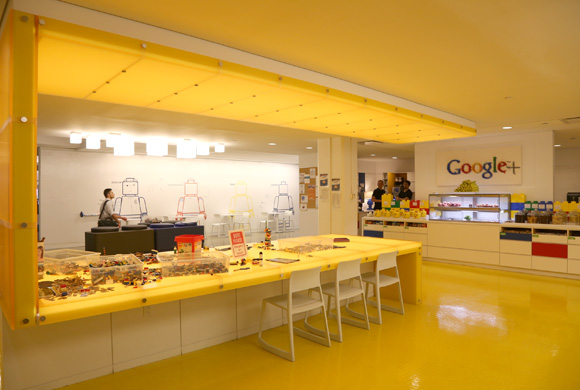
Freedom and clear goals maximize productivity and creativity
The space to make the change to a mix of work and play
[Google] New York, USA
Since Google moved to its current headquarters in Mountain View, California in 2004, it has developed into a company with more than 70 offices in 40 countries around the world. Internet companies often appear to be horizontally organized, but the different branches’ buildings also incorporate the culture of each country, with local flavor visible in the façade. In New York, this means naked brick walls with the charm of the city’s apartment buildings.
Some 3,500 people work in the New York office, with the employees divided about evenly between the Advertising Department and Development Department. The New York office is the base for the development of Google Docs and Google Drive. It’s well known that once you enter the building you will see that Google’s culture of mixing business and fun has been realized. Along with the lines of desks in the work area are spaces for fun—relaxation, stretching, billiards, table tennis—set here and there in the office. At Google, the thinking is that these kinds of activities helps to stimulate the brain in ways that work alone doesn’t. Employees work very hard and play very hard, with minds that are fully motivated.
Employee work is flexible; they are responsible for their results, but how they allocate the time to do their work is entrusted to each person. The engineers in charge of development are often busy from before 11 am, but during the period of low energy from 4 to 5 pm that they call the “afternoon slump,” you’ll see people enjoying some snacks or playing games. There are between 50 and 60 game and sports clubs, and many employees get together regularly to share their hobbies together (we also heard that the Tokyo office has nearly 100 clubs). This free atmosphere is reminiscent of the lifestyle of American college students
Google executives place a high value on ensuring employee creativity, and work to create an environment that provides both freedom and clear goals, says Product Manager Jonathan Rochelle. “At Google, employees are assigned very challenging goals,” he says. “Therefore, we make allowances for mistakes, and management is aware that we won’t meet all our goals. Because of this, we think it’s very important to prepare an environment where the employees enjoy coming to work.”
To do this, it’s important that executives be decisive. Prioritizing work, and providing direction to subordinates about what should be the first thing to do. Otherwise, the office would be crushed under the massive volume of work, leaving everyone exhausted. “For project managers and innovators, the most important skill of all is decisiveness,” Mr. Rochelle says. A decision brings with it the need for courage, and without the decision it’s impossible to resolve problems. It’s not that one postpones the stress that comes with a decision, but rather that one has self-confidence to make the decision, which is also an attribute of a leader.
Of courses, there are many different levels of problems that require a decision, so everyone in the office must make decisions on a daily basis. For Mr. Rochelle, each of the members of a team always make the very best decisions and activity lead the project in the right direction. “It’s often the case that the person who makes decisions who has more ideas than others,” Mr. Rochelle says.
 Established: 1998
Established: 1998
Headquarters: Mountain View, California
Sales: Approx. US$5 billion (2012)
Employees: Approx. 45,000
The New York office is housed in the spacious Empire Square Building, the second-largest building in New York City. It was initially established for the Advertising Department, but the Engineering Department was also established.
http://www.google.com/
 Just past the reception is a computer museum area displaying a variety of old devices. This is to honor and remember technology.
Just past the reception is a computer museum area displaying a variety of old devices. This is to honor and remember technology.
 Jonathan Rochelle
Jonathan Rochelle
Product Manager
Of course, bad decisions are made. The most important material used when considering an issue is data. It’s important for a person to have their own opinion, but data is necessary in order to ensure that this moves in the right direction. At Google, the culture is such that employees state their own opinions, and when it’s time to make a decision everyone will discuss what data is necessary to form the foundation for the decision.
“Data is always essential, and at Google it is a very important part of our culture,” Mr. Rochelle says. “In the process of innovation, all team members must share the same values and be open and honest. When I make a mistake, it’s important to have the attitude that everyone shares the recognition of this.”
I tried this for myself, but it didn’t go well. This was the reason for it: an environment in which the team always accurately shares information depends on the speed of innovation. “We’re not embarrassed about mistakes,” Mr. Rochelle says. “The issue is in being open about the mistake, and use it to think about how to avoid the next mistake.”
One system that Google has instituted to help ensure the creativity of its employees is the famous “20% Time” rule. It was decided that employees can spend 20 percent of their work hours on activities outside their area of work responsibility. In other words, they spend one day each week on other products or activities that they are interested in, using the time to improve themselves. Google sees this as one key to continuing to maintain interest in work.
The idea behind this rule in a bigger context was the methodology of a Google management opinion known as “70% • 20% • 10%.” These figures represented the way in which management resources should be allocated: 70 percent is for the core business, 20 percent for things related to that core business, and 10 percent is to be allocated for completely new business. At Google the rule is applied at both large and small organizational levels as a way to improve both productivity and innovation. For example, in a 10-person team, seven people will be taking on a project with a head-on attack, two will be working on the periphery of the project with new trial-and-error efforts, and one person will be working on something completely unrelated to what the others are doing.
Engineers such as the team involved in the development of GoogleDocs will spend their 20 percent of working time, or one day a week, with other development teams (such as the Search Division). Working regularly with other team members at first glance would seem to be inefficient, but there is a major benefit in that people can teach each other about technology, develop new ideas, and use the stimulation of coming together to increase their passion for their work. It’s also not uncommon for an employee to continue to join in the work of the team, so the process plays a role in the company’s desire to recruit the right people for the right job.
The activities individual employees take on under the 20% Rule include many different things. “Many activities are related to engineering, but it doesn’t have to be so,” Mr. Rochelle says. There are employees who go to teach programming at schools one day a week, while others clean area parks. Others have created opportunities to work with local children, such as helping underprivileged children or working through an NPO as part of these activities.
Employees who have learned a variety of things through these activities bring them back to the organization. This has helped to create the growth and high level of development at Google. The free atmosphere in which employees can take independent action makes for a fertile ground for the release of new ideas into the surrounding departments. Google management feels that the rule did not develop from innovation itself, but was born from spontaneous creativity.
Talking about an environment that works to ensure motivation, Google has also worked hard in the area of food service. “People can enjoy a wide variety of delicious and healthy meals at no cost,” Mr. Rochelle explains. “This is one of the most important ways to ensure employee productivity.” The cafeteria within the building is open 24 hours a day, serving three meals a day during fixed times. It’s a surprisingly big thing to be able to enjoy a meal without having to leave the office, and the mealtime becomes an opportunity to take a complete break from work. Leaving the office, finding an outside restaurant, eating and then returning can take up a lot of time.
Mr. Rochelle thinks that the work area is a bit crowded with desks, but adds that employees are so concentrated on their work that they don’t seem to notice very much. This is also because they arrange the desks as they like, part of the employees creating the work environment that they want. They are also encouraged to decorate the area around the desks, so you’ll see toys, plants and other ways in which people show their individuality. For a change of pace, people will take their laptops and go for a walk, going back and forth between sofas and desks; if needed, people can also work from home.
Google employees face high hurdles. But there are many enjoyable things awaiting at the office. People don’t face their desks with annoyance, but work with happy faces. Google has clearly demonstrated that allowing freedom is a method that significantly improves productivity.
Web-exclusive materials
(April 2013 visit to Google’s New York office)
 Next to the micro-kitchen is the Lego block area, displaying creations by employees
Next to the micro-kitchen is the Lego block area, displaying creations by employees
 One wall is a white board where people can scribble as part of brainstorming.
One wall is a white board where people can scribble as part of brainstorming.






